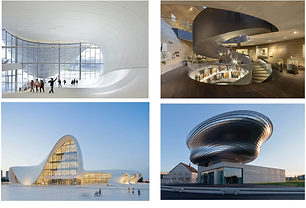ARCH 121


COMPARE AND DİSCUSS
Lokman’s piece highlights leadership and power through vibrant, symbolic Persian-Ottoman imagery, focusing on figures in tiger skins as symbols of strength. In contrast, Hokusai’s Mount Fuji print reflects Japanese tranquility and harmony with nature, using minimalist design to emphasize simplicity and spiritual calm. Lokman’s detailed, flat style prioritizes storytelling, while Hokusai’s Ukiyo-e approach embraces quiet beauty and imperfection, reflecting each culture's distinct values.
WHAT DOES MUSIC MEAN
In Leonard Bernstein's "What Does Music Mean," he highlights the emotional power of music as a universal language. This concept relates closely to our studio discussions on the design process. Just as music conveys feelings and narratives, our designs should evoke emotional responses in our audience. Bernstein's exploration of various musical styles parallels our understanding of diverse design approaches. Each design choice, like a musical note, contributes to a greater message. As we work on our projects, we should consider what emotions we aim to evoke and how to communicate that effectively.
REGULATING LINES
This chapter introduces "Regulating Lines" as a guiding concept in architecture for creating balanced and harmonious designs. Regulating lines are invisible guidelines used to align elements like windows, doors, and facades, ensuring everything fits together in a visually organized way. These lines aren’t random; they’re chosen carefully to create a natural flow and pleasing rhythm in the design.Originating from classical architecture but still essential in modern design, regulating lines blend traditional beauty with contemporary creativity. These lines give buildings a sense of balance and order, making them feel harmonious and cohesive. Understanding and applying regulating lines helps architects design structures that are visually appealing and well-integrated.

COMPARE AND DİSCUSS
The Haydar Aliyev Center and PANEUM Center showcase different approaches to parametric design and part-to-whole relationships. The Haydar Aliyev Center, designed by Zaha Hadid, features organic forms where the entire structure flows seamlessly. Each part of the building, defined by curved lines and surfaces, is interconnected, creating a continuous and cohesive space. In contrast, the PANEUM Center uses parametric design with sharper lines and distinct segments. The building is made up of separate parts, such as the shell-like roof and the rectangular base, which are all connected through the overall design logic. The parts in this structure are more defined but still contribute to a unified whole. Both buildings demonstrate the power of parametric design, but they approach the relationship between parts and the whole differently. The Haydar Aliyev Center integrates everything into one fluid form, while the PANEUM Center uses separate components, maintaining a balance of individuality and unity.